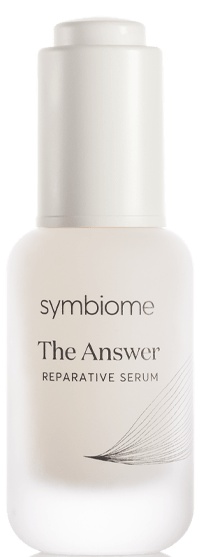
The Answer
Highlights
Key Ingredients
Skim through
| Ingredient name | what-it-does | irr., com. | ID-Rating |
|---|---|---|---|
| Adult Adipose Stem Cell Conditioned Media | cell-communicating ingredient, skin brightening | ||
| Water | solvent | ||
| Lactobacillus Ferment | soothing, preservative | goodie | |
| Caesalpinia Spinosa Gum | viscosity controlling | ||
| Pelargonium Graveolens (Geranium) Leaf Oil | perfuming, antimicrobial/antibacterial | icky | |
| Protium Heptaphyllum (Breu) Resin |
Symbiome The AnswerIngredients explained
If you see "some kind of cell conditioned media" on the ingredient list, it always means a Growth Factor Cocktail for your skin. In this case, we are talking about Adipose-Derived Stem Cells (ADSC), i.e. cells that differentiate later into fat cells. These cells are known to secrete various growth factors that have significant wound healing and antioxidant properties.
If you are new to Growth Factors, they are medium long amino acid sequences (= small proteins = big peptides) that work as a cell signaling molecules to stimulate cell growth, proliferation, healing and/or differentiation. The whole Growth Factors and skincare topic is pretty big and somewhat confusing, so if you want to dip your toes into it, we have a shiny description at Epidermal Growth Factor, the first GF that found its way into cosmetic products and also at Human Fibroblast Conditioned Media, a GF Cocktail similar to this one, but coming from different type of cells.
Good old water, aka H2O. The most common skincare ingredient of all. You can usually find it right in the very first spot of the ingredient list, meaning it’s the biggest thing out of all the stuff that makes up the product.
It’s mainly a solvent for ingredients that do not like to dissolve in oils but rather in water.
Once inside the skin, it hydrates, but not from the outside - putting pure water on the skin (hello long baths!) is drying.
One more thing: the water used in cosmetics is purified and deionized (it means that almost all of the mineral ions inside it is removed). Like this, the products can stay more stable over time.
Lactobacillus ferment is an interesting probiotic ingredient with some promising properties.
First, according to a 2009 Estee Lauder patent, it’s a DNA repair enzyme and it can help to protect the skin against environmental aggressors.
Second, still according to Estee Lauder research but now from 2012 the ingredient has anti-microbial and anti-inflammatory properties and holds promise in the treatment of acne and rosacea. For the former one 5% was needed to show effectiveness, but for reducing skin sensitivity already 1% showed results.
The anti-acne effect is confirmed also by US manufacturer, Barnet, that says that Lactobacillus ferment is helpful in killing harmful bacteria and creating a healthy balanced microflora. Compared to well-known anti-acne and anti-inflammatory salicylic acid the probiotic worked faster at reducing the size and redness of acne lesions.
It also goes by the trade name Leucidal Liquid SF and can serve in the formula as a natural preservative.
Bottom line: It’s not the most proven ingredient (yet) but definitely a very promising one especially if you have sensitive skin, acne or rosacea.

A yellow to brownish essential oil coming from the leaves of Rose Geranium. It contains flavonoid and phenolic compounds that give the oil antibacterial and antifungal properties. The main components though are fragrant ones - citronellol (33%), geraniol (26%) and linalool (10%) - so it might be a good idea to avoid if your skin is sensitive.

You may also want to take a look at...
| what‑it‑does | cell-communicating ingredient | skin brightening |
| what‑it‑does | solvent |
| what‑it‑does | soothing | preservative |
| what‑it‑does | viscosity controlling |
| what‑it‑does | perfuming | antimicrobial/antibacterial |





